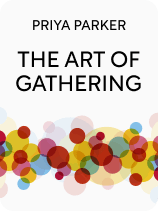

This article is an excerpt from the Shortform book guide to "The Art of Gathering" by Priya Parker. Shortform has the world's best summaries and analyses of books you should be reading.
Like this article? Sign up for a free trial here.
Have you ever attended a conference and couldn’t wait for it to end? Have you ever gone to a wedding and felt there was something missing?
Experiences like these inspired Priya Parker, an expert on gatherings, to write The Art of Gathering. She presents a step-by-step guide to transforming your gathering into a meaningful event that people will talk about for years.
Keep reading for The Art of Gathering quotes that represent the main ideas of Parker’s guide to transforming an event.
The Art of Gathering Quotes to Throw the Best Party
If you’re getting a group of people together, you want them to have a good time. As a host, it’s your job to ensure that everything runs as smoothly as possible.
Below we’ll look at three The Art of Gathering quotes that will make this process easier for you.
“Your opening needs to be a kind of pleasant shock therapy. It should grab people. And in grabbing them, it should both awe the guests and honor them. It must plant in them the paradoxical feeling of being totally welcomed and deeply grateful to be there.”
Parker explains that you must open in a way that sets the tone for the gathering.
Parker argues that opening right matters: Studies suggest that most people tend to remember beginnings—so how you open will linger most in people’s memory. However, most hosts at gatherings open with organizational matters, such as by thanking sponsors. At best, opening with organizational matters misses an opportunity to harness the pre-gathering momentum you’ve created into a powerful moment. At worst, it may undermine the reason for gathering. For example, if you frame a conference as game-changing and disruptive but start with a boring list of rules, you send the message that you’re following old rules.
To open right, Parker recommends that you first make your guests feel accepted and grateful to be at the gathering. This will make them feel like they’re part of something special. Parker describes how one professor memorized every student’s name and then greeted each by name on the first day of a 70-person class: This made the students feel special and demonstrated the professor’s impressive ability.
Second, Parker suggests that you create a collective among your guests. As a host, it is your job to make the guests feel like they are part of a group. One simple way to do this is to get your guests to acknowledge each other’s presence and learn something about each other. For example, you might ask your conference attendees to introduce themselves to each other at the table.
“In a group, if everybody thinks about the other person’s needs, everyone’s needs are actually fulfilled in the end. But if you only think about yourself, you are breaking that contract.”
Parker explains that despite how it may seem at first glance, limiting your guest list is a compassionate act. If you invite people who don’t support your reason, they may actively sabotage it. But even if they don’t, they’ll still undermine your reason because they’ll inevitably distract you (as the host) with their presence. As a result, you won’t give your full attention to the guests for whom the gathering is designed. In this way, not inviting people who don’t actively support your reason is an act of compassion toward the guests you do invite.
For example, you might travel with your bridesmaids to New Orleans for a bachelorette party so that your bridesmaids, who don’t know each other well, can bond before the wedding. If one bridesmaid has a friend who lives in New Orleans, she may ask if this friend can come to an event you have planned. This friend might sabotage your gathering by dragging your bridesmaid away from the group and having a long conversation with just her. But even if she doesn’t, you’ll be distracted by this friend’s presence; instead of focusing on making sure that your bridesmaids are connecting with each other, you’ll be focused on making sure this friend is having a good time.
When limiting the size of your gathering, Parker recommends that you keep in mind both who and how many people support the purpose. If you want a small, intimate group, limit your gathering to six to 12 people. If you want to foster intimacy while still allowing for diverse perspectives, you can have up to 15 people. For a more animated, party-like vibe, invite 30 people. And if you want a big gathering, a group of 150 people feels large but still connected.
“Take the reasons you think you are gathering—because it’s our departmental Monday-morning meeting; because it’s a family tradition to barbecue at the lake—and keep drilling below them. Ask why you’re doing it. Every time you get to another, deeper reason, ask why again. Keep asking why until you hit a belief or value.”
While most hosts assume that the gathering begins when everybody arrives, Parker argues that in reality, the start of your gathering is whenever you tell a guest about it. So during the lead-up to your gathering, you should set expectations with your guests so that they have a clear idea of what will happen.
Parker contends that setting clear expectations during the lead-up to your guests’ arrival is essential for two reasons. First, setting expectations will help your guests get into the right mood. As a result, they’ll arrive at the gathering feeling more open to fully participating in the experience. Second, setting expectations prevents guests from feeling cheated. It reduces the possibility that your guests will feel disappointed because their own (incorrect) expectations for the gathering were unfulfilled.
Parker recommends two strategies for setting clear expectations. First, name your gathering. The right name will communicate to your guests both what they should be doing during the gathering and how the gathering relates to their roles. For example, is your business gathering a workshop or a seminar? A workshop implies that your guests will need to be active and possibly brainstorm ideas during the gathering, while a seminar suggests that your guests will be more passive and perhaps take notes while listening to a lecture.
Second, ask people to do things that encourage them to arrive at the gathering in the right mindset. For example, if you want to hold a year-end business meeting to reflect on your accomplishments, you might ask people to think of someone they want to celebrate (if the mood is celebratory) or ask them to name some challenges (if the mood is more reflective).

———End of Preview———
Like what you just read? Read the rest of the world's best book summary and analysis of Priya Parker's "The Art of Gathering" at Shortform.
Here's what you'll find in our full The Art of Gathering summary:
- How to make pre-planned gatherings more meaningful and engaging
- What to do before, during, and after any type of gathering
- Why the host should never relax during their event






